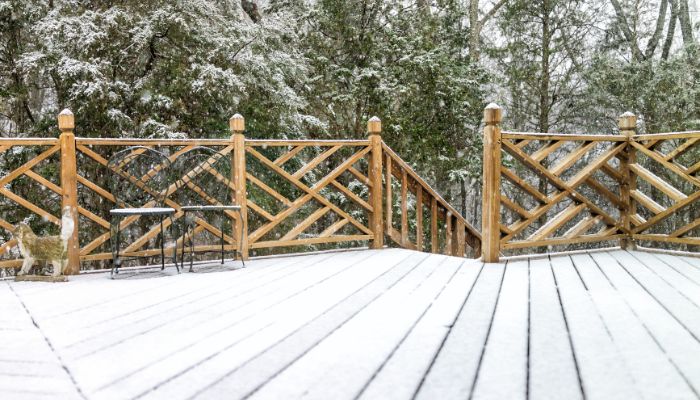Decks are great add-ons for your home, but when the surface is wood, they will be susceptible to water damage. To keep your wood deck in working condition, you must protect the structure during the winter and prevent as much damage as possible. With winter knocking on our back door, now is the time to take the extra steps to reduce the deterioration of your wood deck.
Remove Debris and Clean the Deck
Before you take any steps to protect your deck, you must remove debris and mildew from the surface and clean the wood. Transfer any plants inside your home, store furniture, and cover grills. The more items and debris you leave behind, the more moisture damage can occur. Snow accumulates because the debris locks in the water, allowing it to seep into your deck.
As for a cleaning agent, you can purchase a store-bought mildew cleaner, but we suggest making one yourself with products you already have in your home. Mixing hot water, ammonia-free dish soap, and dry organic oxygen bleach will provide the most power to scrub away mildew. The excess moisture from the winter weather will create new mildew, so it’s best to stay ahead of the game by removing as much of it as you can before the first snowfall.
Seal the Deck With Water Repellant
A water-repellant seal is one of your better options for protecting your wood deck in the winter. However, you might need to remove and sand away prior sealants and finishes before applying this new one. When you do not seal the wood, moisture can warp the material and cause cracking and splintering. Seal your deck this winter so that it’s damage-free and in excellent condition once spring arrives.
Use a Tarp Covering
If you don’t have enough time to remove previous finishes and reseal your deck, you might consider covering the wood with a tarp for added protection. This covering will provide a barrier between the snow and the wood to help prevent moisture damage. It’s best to strap the tarp down or lay bricks on top to keep the wind from blowing it away and exposing your wood.
Consider Composite Decking Next Year
Sometimes, a homeowner will prefer something other than the traditional look of a wood deck because of the necessary upkeep. Consider a composite material made from wood fibers and recycled plastic—it’s water-resistant and almost maintenance-free! If the composite material is not something you want, but your deck has substantial damage, we recommend hiring a deck restoration professional in the spring to revitalize your deck.
The deck on your home is most likely a favorite spot for the family to hang out during the summer. Protecting your deck in the winter will increase the structure’s lifespan and ensure everything is in top condition once the warmer months arrive. Don’t let your deck deteriorate this winter—protect it with these tips!







